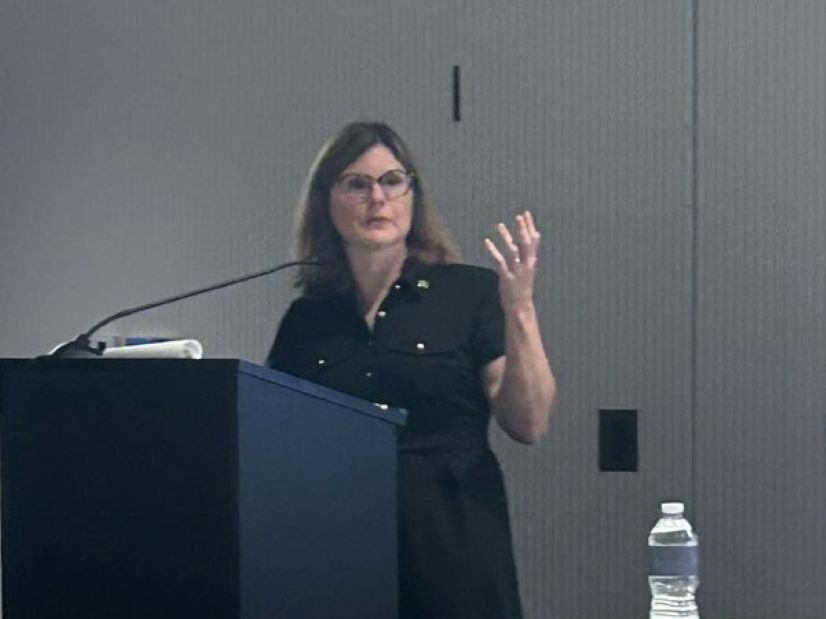
WASHINGTON — FERC Commissioner Allison Clements said last week that Order 1920 will make it easier for states to address the changes facing the industry.
Rehearing requests have come into FERC, and some states are argue the commission cannot impose the new transmission planning and cost allocation rules on them, Clements said at the annual meeting of the Energy Bar Association’s Northeast Chapter. The issue of states having the authority to protect their consumers from costs of external policies drove Commissioner Mark Christie to dissent from the order, which Clements and Chair Willie Phillips responded to in a concurrence. (See FERC Issues Transmission Rule Without ROFR Changes, Christie’s Vote.)
“Good luck to the states who think they’d be better off going at this alone. Good luck to the economic development opportunities that your state faces. Good luck to the health and safety of your citizens in extreme weather,” Clements said. “I mean, I don’t know that there’s any other way to get there besides all the solution sets, and regional transmission and inter-regional transmission has to be at the top of that list, at least in the FERC-jurisdictional bucket.”
The changes ultimately are an incremental step from what FERC did more than a decade ago in Order 1000, and it rests on a firm legal framework, Clements said. It should stand up in court in the face of any appeals.
“The reality is that this money is getting spent every year anyways, $20 [billion] to $40 billion a year on annual spending on transmission,” Clements said. “It has to be the commission’s responsibility to try and direct that money towards more cost-beneficial outcomes for customers.”
Along with Order 1977 implementing the commission’s rules on National Interest Electricity Transmission Corridors, and Order 2023 that revised interconnection queue rules, 1920 is meant to help address the rapid changes the industry is facing from new demand to a changing resource mix, Clements said.
“I think the whole time I’ve been here, I’ve been focused on what I set out to do in this role, which is to facilitate affordable and reliable electricity as the world around us changes,” Clements said. “It’s not our job to dictate where the world goes; it’s our job to facilitate affordable and reliable electricity service in light of where it’s going.”
Until this year, load growth in most of the country had been flat, but that has changed with new demand from data centers, reshoring manufacturing and ongoing efforts at electrification. It’s unclear how much demand will grow, even in the near future, she said.
“I don’t think we know that it’s going to be a 5% increase in U.S. consumption in the next five years,” Clements said. “We can estimate that; we can model that; we’re sure to be wrong.”
The new demand is cropping up in specific areas, and potential shortages are going to occur only part of the year, but investments to bolster the grid are likely to be “low regrets” for the near future, she added.
“I think we’re not yet at the point where we need to start worrying about the ‘no one’s going to show up,’” Clements said. “The top thing I hear from companies, whether it’s tech companies or advanced manufacturing companies, is that we are shopping for location, with the No. 1 priority being, ‘where is there available capacity on the grid?’”
The low-regrets case is bolstered by the fact the grid has plenty of room for improvement with advanced grid-enhancing technologies (GETs) that can affordably make the existing system more efficient, she said. The Brattle Group estimates such technologies could double the amount of renewables online now absent major investment in new transmission, but even if the reality is half that, GETs are a worthy investment, Clements said.
Clements will step down this month after the open meeting June 27, having served three and a half years. Her replacement, Judy Chang, was confirmed by the U.S. Senate the same day she spoke.
“It has flown by for me, personally. I’m not sad for it to be over for my sake and my family’s sake,” Clements said. “But … all of the work we’re doing is pretty important. You know, I’m really proud of helping to establish our first Office of Public Participation. I think it’s a really long row to hoe to think that you’re going to actually engage members of the public in our esoteric, technocratic conversations, but we’re on our way.”


